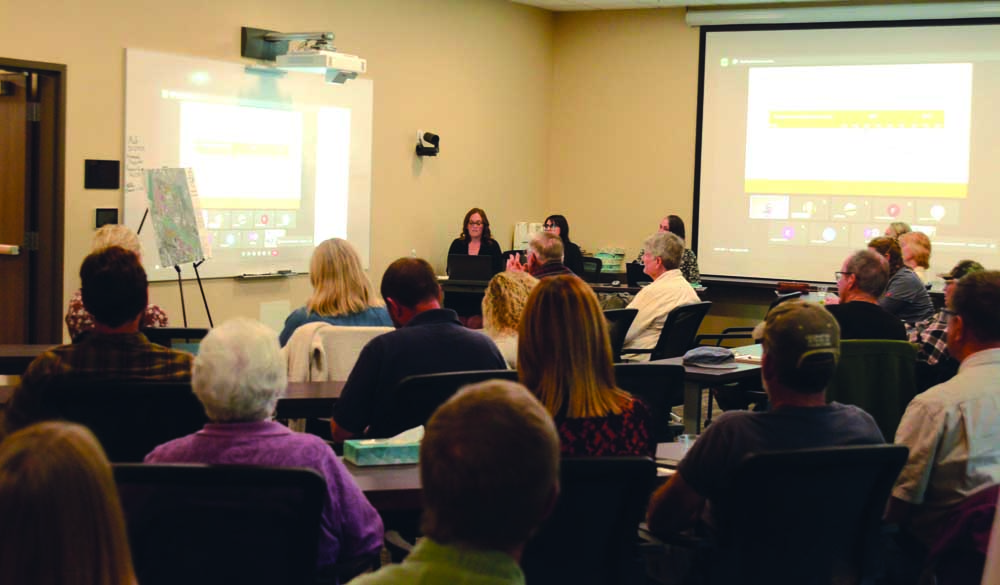2022 news in review: Officials, residents seek answers to housing crunch
Published 7:00 am Wednesday, December 28, 2022

- About 50 people gathered Wednesday, Oct. 19, 2022, at a conference room at Hearts for Health for a public forum on affordable housing in Enterprise. Another 10 people attended online. The forum was hosted by the city’s Planning Commission and City Council. The meeting was part of a developing discussion about a housing shortage in Enterprise and Wallowa County.
ENTERPRISE — The shortage of housing in Wallowa County came into sharper focus in 2022, with government agencies, nonprofit organizations, community groups and others taking a deeper look into the issue and starting to brainstorm possible strategies.
In general, residents and officials agreed on several key points during the year:
Trending
• The housing crunch isn’t unique to Wallowa County — it’s a big issue throughout Oregon. Some estimates are that the state is short some 111,000 housing units, primarily those that would help lower-income families. Josh Lehner, a state economist, has said filling that shortfall will require not only more construction workers, but government workers in planning and building departments.
Said Megan Loeb, the Oregon Community Foundation’s senior program officer for economic vitality and housing: “We need affordable housing, we need subsidized housing. We need market-rate housing.”
• The housing crunch didn’t emerge overnight — and it will take time to solve.
“There are some really broad economic factors that are causing this everywhere, not just in Wallowa County,” said Sara Miller, deputy director of the Northeast Oregon Economic Development District, a nonprofit organization that works to help entrepreneurs, businesses and communities in the region.
One key, Miller said, is that after the recession in 2007, housing starts fell off throughout the United States, including Oregon. “It has taken us decades to get us to this crisis point and it’s going to take decades to get out,” she said.
• The housing shortage is taking a toll on Wallowa County businesses throughout the county. Without so-called “workforce housing” — that is, housing that employees can afford — it becomes harder to attract new workers to the county.
Trending
That’s been an issue for Miller’s organization as well: She said the NEOEDD frequently uses volunteers from the AmeriCorps program. But recently, she said, those volunteers have been unable to find places to live in the county.
• It’s a problem that will take creative collaboration between a variety of partners — governments, private companies, nonprofit organizations and others — to solve.
Rural areas such as Wallowa County face unique challenges in developing housing, said Loeb, including a lack of access to financial resources and workforce shortages, not just in construction but also in local governments charged with permitting and building infrastructure.
Other factors are more unique to Wallowa County. Diane Daggett, a Wallowa County Realtor and a board member of the Wallowa County Chamber of Commerce, said a rise in property values in the county creates another hurdle for developers wanting to build housing. And, she said, the rental market has been affected by new state regulations on landlords, which have persuaded some landlords to simply remove their properties from the market.
“We’ve lost a huge pool of houses that way,” Daggett said.
Nevertheless, she said, she’s gratified to see a number of other organizations and entities dive into the issue and emphasized that it would take private-public partnerships to make a dent in the problem. She had praise for the city of Enterprise for its work thus far on the issue.
In fact, Enterprise officials held a town-hall meeting earlier this year with officials from the state Department of Land Conservation and Development to examine the housing crunch. The meeting was well-attended.
But Wallowa County Commissioner John Hillock said he’s frustrated with what he’s hearing thus far from the state department. He said a department survey looked at Enterprise and concluded that the city has plenty of vacant lots where housing units could be built.
Hillock said the survey missed something vital: “The problem is that because we have this tourism-recreation part of our economy, it’s raised the values of everything so high that the vacant lots are too expensive for someone in the workforce to buy and develop, because some tourist can buy it and they can afford it. We need to convince the DLCD of this, and I’ve been working on this in meetings the last couple of months, but I haven’t gotten there yet.”









